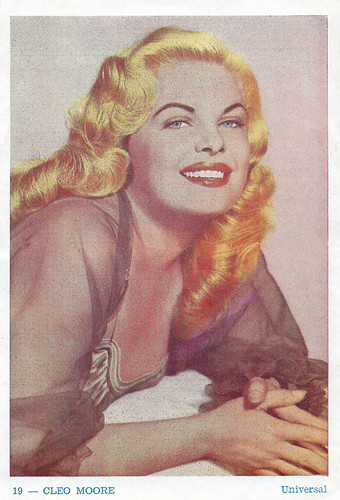
British postcard in the Greetings series. Photo: Universal-International.
The Blonde Rita Hayworth
Cleouna Moore was born in Galvez, Louisiana, in 1924 (Wikipedia writes 1929) and raised in nearby Gonzales. Her father ran a grocery store there and was later a building contractor. She had three sisters: Mari, Voni, and Jonnie. Cleo was educated in Gonzales public schools and took a secretarial course at Pope's Commercial College in Baton Rouge.
In 1944, she married Palmer Long, the youngest child of Huey Long, the former governor of Louisiana who was assassinated five years earlier while a Senator for Louisiana. However, the marriage ended in six weeks. After Cleo finished high school, she moved with her family to California where her father was anticipating the end of World War II and the building boom that was expected to follow.
Moore was named Miss Van Nuys from 1947 to 1948. She was spotted by an RKO executive and was convinced to take a screen test. In 1948, she made her film debut in Embraceable You (Felix Jacoves, 1948) and also played the leading lady in the film serial Congo Bill (Spencer Gordon Bennet, Thomas Carr, 1948), based on the DC Comics character Congo Bill. After that fiasco, Cleo went back to work at her family's building business and did some modelling.
In 1950, she worked briefly for Warner Brothers, and from 1950 to 1952, for RKO Radio Pictures. For RKO, she made such films as the Film Noir Hunt the Man Down (George Archainbaud, 1951) with Gig Young, and Gambling House (Ted Tetzlaff, 1951) starring Victor Mature. She signed with Columbia Pictures in 1952. The studio had plans to mould Moore as its next film star, hoping she would bring Columbia the success that 20th Century Fox was having with Marilyn Monroe. In order to compete with Monroe, Moore had to bleach her hair platinum blonde. Columbia dubbed her "The Next Big Thing" and "The Blonde Rita Hayworth". She first gained attention as a doomed gun moll in Nicholas Ray's Film Noir On Dangerous Ground (1952) with Ida Lupino and Robert Ryan, but it was still a minor part.
Moore began starring in films and the following year, she made one of her most remembered films, the low-budget Film Noir One Girl's Confession (Hugo Haas, 1953), opposite Haas himself. Hugo Haas directed and appeared with her in several other films in which he played an older man ruined by Moore's seductive charms. She co-starred in Thy Neighbor's Wife (Hugo Haas, 1953) and Bait (Hugo Haas, 1954), the latter co-starring John Agar. In 1954, she starred in The Other Woman (Hugo Haas, 1954), playing a B-movie bit player who strikes at a film director when he declines to offer her a role in his picture. In 1954, Moore's career began to fade in the eyes of Columbia. The studio signed newcomer Kim Novak to a contract and started moulding Novak as its new star on the lot. Moore was cast in forgettable B-movies including a supporting role in Women's Prison (Lewis Seiler, 1955) with Ida Lupino, which fared well at the box office.

British postcard in the Greetings series. Photo: Universal-International.

British postcard in the Greetings series, no. B. Photo: Universal-International.
Publicity stunts
Cleo Moore signed a brief deal with Universal Pictures to play a suicidal prostitute in the low-budget thriller Hold Back Tomorrow (Hugo Haas, 1955), again opposite John Agar. In 1956, she starred as a predatory career girl in Over-Exposed (Lewis Seiler, 1956), co-starring Richard Crenna.
The following year, Moore made her final film appearance in Hit and Run (Hugo Haas, 1957) with Vince Edwards and her sister, Mara Lea. She had star billing, but it was another box-office bomb and Moore retired from acting.
Despite never achieving true film stardom, Moore made headlines with several publicity stunts. In 1954, she caused a scandal while doing a live Chicago TV promotional kiss with Jack Eigen, radio and TV veteran for ABC affiliate WBKB, in what he terms an experiment testing the reaction of TV audiences. The kiss lasted approximately 5 minutes and 17 seconds. Both were sitting in separate seats and Eigen was fired after protests from hundreds of women viewers. In 1955, she announced on an NBC talk show that she would eventually run for governor of Louisiana. The following year, she repeated that she would do so in 1960. But of course, she never did.
Instead, Moore found success as a businesswoman in real estate after her screen career had ended. After her six-week marriage, at age 15, to Palmer Long, Cleo Moore remained single through the 1940s and 1950s. In 1961, she married multi-millionaire real estate developer Herbert Heftler and lived on an estate on Coldwater Canyon in Beverly Hills for the remaining 12 years of her life.
Cleouna M. Heftler died in her sleep of a heart attack at the age of 48 in 1973. She is interred at Inglewood Park Cemetery, Inglewood, California. She had a daughter named Debra Lee Heftler (1963). After her sudden death, Cleo Moore began to attract a cult following in the 1980s with airings of her bad-girl movies on television. In the 1990s, Sony Pictures released three Moore titles — Over-Exposed, One Girl's Confession, and Women's Prison — in a DVD set entitled 'Bad Girls of Film Noir Volume II'.

Belgian collectors card by Merbotex, Bruxelles, for Metro, Niel, no. 19. Photo: Universal.

American Arcade postcard.
Sources: Denny Jackson (IMDb), Hal Erickson (AllMovie), Glamour Girls of the Silver Screen, Wikipedia, and IMDb.
No comments:
Post a Comment